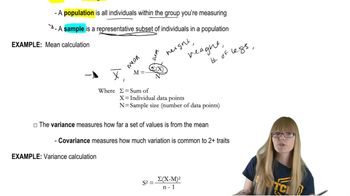Type A1B brachydactyly (short middle phalanges) is a genetically determined trait that maps to the short arm of chromosome 5 in humans. If you classify individuals as either having or not having brachydactyly, the trait appears to follow a single-locus, incompletely dominant pattern of inheritance. However, if one examines the fingers and toes of affected individuals, one sees a range of expression from extremely short to only slightly short. What might cause such variation in the expression of brachydactyly?
Table of contents
- 1. Introduction to Genetics51m
- 2. Mendel's Laws of Inheritance3h 37m
- 3. Extensions to Mendelian Inheritance2h 41m
- 4. Genetic Mapping and Linkage2h 28m
- 5. Genetics of Bacteria and Viruses1h 21m
- 6. Chromosomal Variation1h 48m
- 7. DNA and Chromosome Structure56m
- 8. DNA Replication1h 10m
- 9. Mitosis and Meiosis1h 34m
- 10. Transcription1h 0m
- 11. Translation58m
- 12. Gene Regulation in Prokaryotes1h 19m
- 13. Gene Regulation in Eukaryotes44m
- 14. Genetic Control of Development44m
- 15. Genomes and Genomics1h 50m
- 16. Transposable Elements47m
- 17. Mutation, Repair, and Recombination1h 6m
- 18. Molecular Genetic Tools19m
- 19. Cancer Genetics29m
- 20. Quantitative Genetics1h 26m
- 21. Population Genetics50m
- 22. Evolutionary Genetics29m
20. Quantitative Genetics
QTL Mapping
Problem 29d
Textbook Question
In 1988, Horst Wilkens investigated blind cavefish, comparing them with members of a sibling species with normal vision that are found in a lake [Wilkens, H. (1988). Evol. Biol. 25:271–367]. We will call them cavefish and lakefish. Wilkens found that cavefish eyes are about seven times smaller than lakefish eyes. F₁ hybrids have eyes of intermediate size. These data, as well as the F₁ × F₁ cross and those from backcrosses (F₁ × cavefish and F₁ × lakefish), are depicted below. Examine Wilkens's results and respond to the following questions:
Wilkens examined about 1000 F₂ progeny and estimated that 6–7 genes are involved in determining eye size. Is the sample size adequate to justify this conclusion? Propose an experimental protocol to test the hypothesis.

 Verified step by step guidance
Verified step by step guidance1
Step 1: Understand the problem. The question is asking whether the sample size of 1000 F₂ progeny is adequate to justify the conclusion that 6–7 genes are involved in determining eye size in cavefish. Additionally, it asks for an experimental protocol to test this hypothesis.
Step 2: Recall the concept of polygenic inheritance. Traits controlled by multiple genes, such as eye size, often show continuous variation. The number of genes involved can be estimated using statistical methods, such as the number of phenotypic classes observed in the F₂ generation. The sample size must be large enough to detect these classes reliably.
Step 3: Evaluate the adequacy of the sample size. To justify the conclusion that 6–7 genes are involved, the sample size must be sufficient to distinguish between phenotypic classes. The formula for estimating the number of phenotypic classes is 2n, where n is the number of genes. For 6–7 genes, this would result in 64–128 phenotypic classes. A sample size of 1000 may be adequate if the phenotypic differences are distinct and measurable.
Step 4: Propose an experimental protocol. To test the hypothesis, perform a controlled cross between cavefish and lakefish to produce F₁ hybrids. Then, cross F₁ hybrids to produce F₂ progeny. Measure eye size in the F₂ generation and analyze the distribution of phenotypes. Use statistical methods, such as chi-square tests, to determine if the observed phenotypic distribution matches the expected distribution for 6–7 genes.
Step 5: Include additional controls and replicates. To ensure reliability, repeat the experiment with multiple independent crosses and measure eye size using standardized methods. Consider environmental factors that might influence eye size and control for these variables in the experimental design.
 Verified video answer for a similar problem:
Verified video answer for a similar problem:This video solution was recommended by our tutors as helpful for the problem above
Video duration:
1mPlay a video:
Was this helpful?
Key Concepts
Here are the essential concepts you must grasp in order to answer the question correctly.
Genetic Variation
Genetic variation refers to the differences in DNA sequences among individuals within a population. In the context of Wilkens's study, the variation in eye size between cavefish and lakefish suggests that multiple genes contribute to this trait. Understanding genetic variation is crucial for analyzing how traits are inherited and expressed, particularly in hybrid offspring.
Recommended video:
Guided course

Genomic Variation
Quantitative Trait Loci (QTL)
Quantitative Trait Loci (QTL) are regions of the genome that are associated with a quantitative trait, such as eye size. The identification of 6-7 genes influencing eye size in Wilkens's study implies that these genes may be located in specific QTLs. QTL mapping is a common method used to determine the genetic basis of complex traits, which is essential for validating the hypothesis regarding eye size inheritance.
Recommended video:
Guided course

QTL Mapping
Sample Size and Statistical Power
Sample size and statistical power are critical in experimental design, as they determine the reliability of the results. A larger sample size increases the likelihood of detecting true effects and reduces the impact of random variation. In Wilkens's study, examining about 1000 F₂ progeny provides a substantial sample size, which is generally adequate for estimating the number of genes involved in a trait, thus supporting the conclusion drawn from the data.
Recommended video:
Guided course

Mathematical Measurements
Related Videos
Related Practice
Textbook Question
442
views


